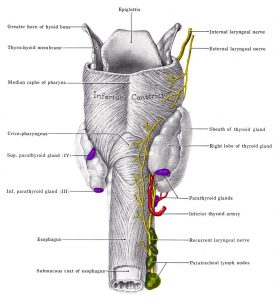Parathyroid Gland Definition
The parathyroid gland is secretory tissue in charge of regulating the level of calcium in our cells. As an ion, calcium serves many important roles in the body. The firing of action potentials in neural cells rely on a depolarized (or positively charged) membrane, which calcium helps accomplish with its positive charge. When the ability to conduct electricity is hindered, it will lead to whole-system disruptions of the nervous system indicative of parathyroid disease including depression and bodily weakness. Calcium also facilitates muscle contraction and even bone rebuilding. Disruptions to the electrical processes of the muscular system will cause those patients to experience muscle cramps and fatigue. The main secretion that allows calcium levels to be regulated is parathyroid hormone (PTH), which acts on existing bone to release calcium and on kidneys to prevent or encourage the release of calcium to urine.
Roles of Ca2+ in the human body:
- Bone support
- Cell signaling
- Blood clotting
- Muscle contraction
- Neural firing
The illustration depicts the area around the parathyroid gland. The parathyroid glands are labeled in purple.
Parathyroid Gland Function
The parathyroid gland’s main role is in secreting hormone PTH. PTH (or parathyroid hormone) acts by raising the levels of calcium in the blood. This is accomplished by PTH’s ability to do three things. First, PTH can stimulate bone breakdown, which inherently releases calcium from the stores held within the bone. Second, PTH can also increase the reabsorption of calcium from food, and third, increase the kidneys’ retention of calcium that would otherwise be lost to urine. This tight control of blood calcium levels earns the parathyroid gland’s status as a kind of thermostat. When the blood’s calcium becomes too low, the body will release more PTH which will bring the calcium levels back to normal. In contrast, when calcium levels are too high, the parathyroid gland will stop releasing PTH. Maintenance of proper calcium levels goes a long way. A calcium balance will benefit the heart, the kidneys, the nervous system, and the bones. Low calcium levels can lead to heart, bone, and neural disease.
Parathyroid Gland Location
The animated gif (click image to play) depicts the parathyroid glands in the neck. All four can be visualized (labeled in purple).
The parathyroid gland is found in the neck behind, adjacent, or within the thyroid gland. Another landmark that gives its relative location is the Adam’s apple, which lies next to the parathyroid glands that grace either side of it. The number of glands can vary but most people are born with four. They are about the size of a grain of rice where one lies above the other on each side of the neck. The parathyroid gland will be composed of epithelial cells that excrete parathyroid hormone, and the gland will be richly supplied by capillary beds. The superior, or top, parathyroid gland is supplied by the inferior thyroid arteries, while the inferior, or bottom, gland will receive supply from variable sources like the ascending branch of inferior thyroid artery or the thyroid inferior mesenteric artery. The parathyroid veins drain into a venal thyroid plexus.
In turn, the parathyroid gland’s lymphatic vessels will drain into the deep cervical and paratracheal lymph nodes. The parathyroid gland is innervated by the thyroid branches of the sympathetic cervical ganglia.
Parathyroid Gland Disorder
The most notable disease of the parathyroid glands is an overactive lobe. When too much parathyroid hormone is made, it leads to hyperparathyroidism. This condition is often accompanied with fragile bones, kidney stones, abdominal pain, bone pain, and depression. Primary hyperparathyroidism originates from benign growths on the gland, parathyroid gland enlargement, or most rarely from a cancerous tumor. Secondary hyperparathyroidism, on the other hand, results from a loss of calcium secondary to severe calcium or vitamin D deficiencies. This can originate from the gut’s failure to absorb calcium from our meals. Likewise, chronic kidney failure can inhibit the kidney from converting vitamin D into a usable, active form. Vitamin D allows calcium to be absorbed, so not having enough will cause calcium levels to drop. Risk factors include menopause, prolonged deficiency of calcium or vitamin D, endocrine neoplasms, radiation treatment, or previous exposure to lithium (in bipolar patients).
In contrast, having an underactive parathyroid gland will also result in disease. Hypoparathyroidism will result from an underproduction of PTH. A patient with this disorder will experience paresthesia (or tingling) of the extremities (toes, fingers), muscle aches, muscle spasms, fatigue, and dry skin among other frailties. The causes of hypoparathyroidism can range from having an autoimmune disease, to accidental damage to the parathyroid gland from surgery, extensive radiation treatment, or low levels of magnesium in the blood. Risk factors for hypoparathyroidism often include a family history of hypoparathyroidism or recent neck surgery.
Quiz
1. PTH is primarily involved in the regulation of which ion?
A. Ca3+
B. Na2+
C. Ca2+
D. (CO3)2-
2. Hypoparathyroidism will result from a deficiency of which of the following, per the article?
A. High vitamin D
B. Low PTH
C. High PTH
D. Low gut reabsorption of calcium
3. When calcium levels are too high, the body will __________.
A. produce more PTH
B. increase exposure to vitamin D
C. inhibit PTH release
D. increase gut reabsorption of calcium
References
- The American Association of Endocrine Surgeons (2017). “Parathyroid Glands: Function.” Patient Education Site. Retrieved on 2017-07-01 from http://endocrinediseases.org/parathyroid/parathyroid_background.shtml
- The American Association of Endocrine Surgeon (2017). “Parathyroid Glands: Function.” Endocrine Diseases. Retrieved on 2017-07-01 from http://endocrinediseases.org/parathyroid/parathyroid_background.shtml
- Teach Me Anatomy (2017). “The Parathyroid Glands.” Teach Me Anatomy. Retrieved on 2017-07-02 from http://teachmeanatomy.info/neck/viscera/parathyroid-glands/
- Parathyroid (2017). “Introduction to Parathyroid Glands.” Parathyroid. Retrieved on 2017-07-02 from http://www.parathyroid.com/parathyroid.htm
- Mayo Clinic Staff (2017). “Hypoparathyroidism.” Mayo Clinic. Retrieved on 2017-07-01 from http://www.mayoclinic.org/diseases-conditions/hypoparathyroidism/symptoms-causes/dxc-20318175
Parathyroid Gland


No comments:
Post a Comment